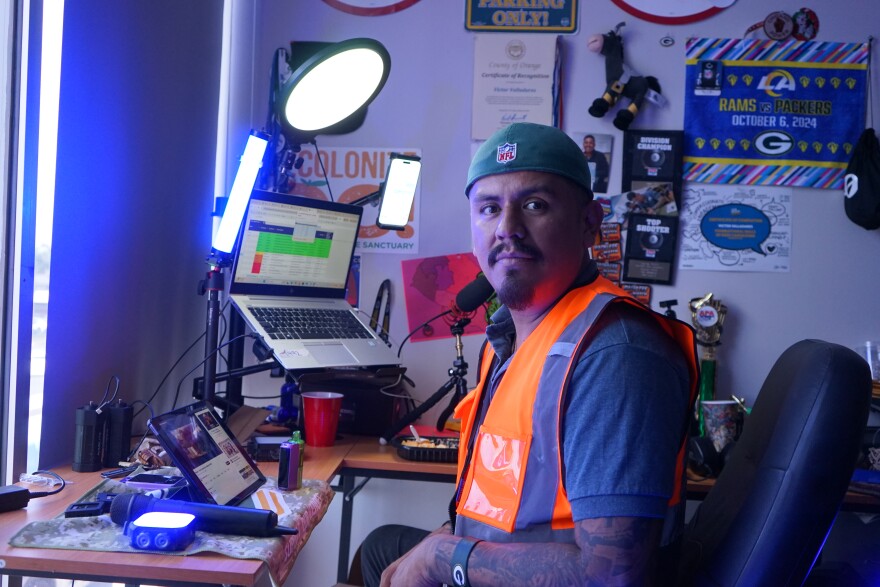Truth matters. Community matters. Your support makes both possible. LAist is one of the few places where news remains independent and free from political and corporate influence. Stand up for truth and for LAist. Make your year-end tax-deductible gift now.
Orange County activists are tracking ICE in their communities and live-streaming what they find

These days, a typical morning for Victor Valladares starts off on Facebook.
The community organizer from Huntington Beach is up with the sun, and before long he's shooting off a message to his more than 30,000 followers: "Listo!"
His first post of the day tells the community he's ready to go — and so is a whole group of activists he's working with. Then the tips start pouring in.
Since June, Valladares has joined a growing number of people across Southern California who are tracking immigration agents in their neighborhoods. If he receives a message from someone reporting a suspicious vehicle on their street, or what looks like ICE agents at a location somewhere in Orange County, Valladares will hop in his car and head that way.
En route, he'll start live-streaming what he sees in Spanish.
It's not work he does alone. Over the past five months, Valladares told LAist he's been building a network of dozens of community members that work together to receive reports of immigration enforcement sightings, check them out on the ground, and report back to people in real time. These efforts are part of an even wider web of community organizations monitoring ICE and sharing reports on social media and in group chats.
"We've been successful in documenting when ICE is present in Orange County," Valladares said from an office space in Costa Mesa where he films some of his Facebook videos. "We're usually the very first response. We share information with community. We go live."
A spike in immigration enforcement in Southern California has also led to a heightened climate of fear. Social media feeds are teeming with videos and photos of people being detained by masked federal agents. Because of this, community organizers told LAist that there's also been an increase in misinformation. That's where they try to step in.
Valladares said the group operates by first having a team of people respond to online reports of immigration agents or vehicles that look suspicious. Then, people he calls "patrollers" head out to the location in person to check things out for themselves.
One of those patrollers is Addie Tinoco, a Santa Ana resident who got involved over the summer after seeing social media videos of people being detained in her neighborhood. The first time she decided to try to monitor immigration enforcement, she was acting alone. After hearing reports that immigration agents had been spotted on a county bus, she showed up in the area and filmed ICE agents arresting a man on the street.
"That was really the first time that I felt like really sparked something, because I got to witness it not just through the screen. This was happening in real life, in real time, to a real person in a city that I grew up in," she said. "I didn't want to encounter something like that and not be well prepared."
After that, she started driving the streets looking for ICE, and doing trainings with community groups like Unión del Barrio and OC Rapid Response Network. A Home Depot in Santa Ana became her mainstay. She started linking up with other people doing the same thing. Over the weeks, they started to build networks of communication.
These groups are disparate and varied, but organizers told LAist they are linked by one key ingredient: trust. Valladares told LAist that his organizing focuses on reaching the people who most need reports on immigration activities by spreading information from one verifiable source to another. It's like a phone tree, but for reporting ICE activity.
Maria Garcia is part of that web of communication. She lives in Fontana, and works with groups in the Inland Empire and Orange County to receive reports of immigration agents and then report back what people on the ground have learned.
She does this work from her home, on the phone. It regularly brings her into contact with people who are afraid to leave their homes. On a recent day, Garcia said she spoke with someone who had to go to the hospital, but feared encountering federal agents on the way.
"We don't like to spread fear. That's our main goal," she said. "We like to empower people to be able to go to the grocery store or to the hospital. We give them tools so they feel safe."













